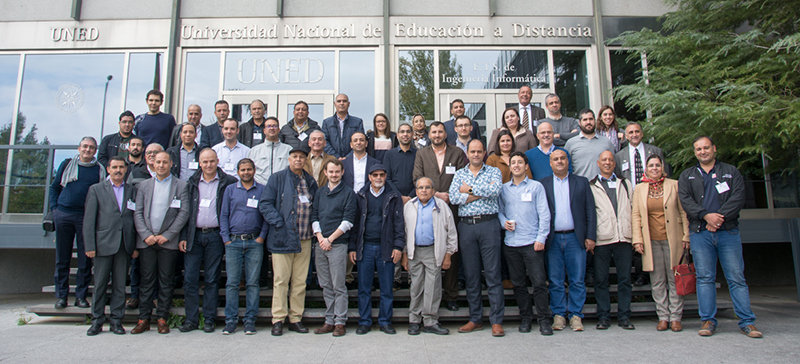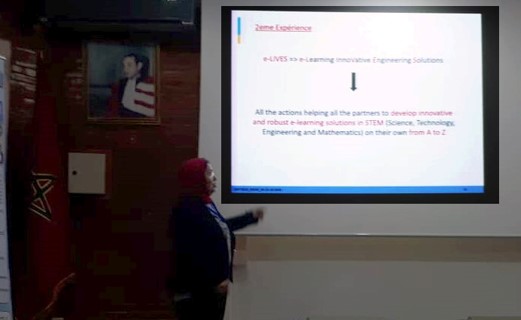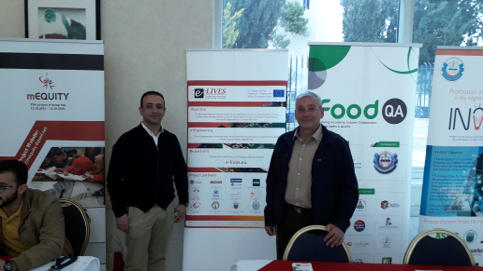|

Call for Papers
The INTERNATIONAL e-ENGINEERING EDUCATION SERVICES CONFERENCE (e-ENGINEERING’2020) is the world’s premier forum dedicated to presenting and discussing e-Engineering courses implementation. The goal is to exchange ideas and best practices in all aspects related to the set up of e-Engineering courses, with a focus on undergraduate and graduate courses as well as vocational and lifelong learning training.
The conference seeks to disseminate the concept of e-Engineering, and the responses it brings to the continuous need for enlarging and improving engineering education in a rapidly changing world.
e-ENGINEERING’2020 will take place June 23-24, 2020, at Petra Marriott Hotel, in Petra, Jordan, organized by the Tafila Technical University (TTU). The conference has the technical co-sponsorship of the IEEE Education Society and of the IEEE Jordan Section.
We invite you to submit original and unpublished works related to the conference topics. Please, take a look at the Call for Papers available on the conference website e-engineering.org
|
The e-LIVES 2nd General Assembly
The 2nd General Assembly of the e-LIVES project took place in the beautiful city of Madrid between the 5th and the 7th of November, 2019.

During the three days of the meeting, partners assessed the current development of the project activities and set the goals for the last twelve months of the project. The 3rd and last General Assembly of the project will take place in Petra, Jordan, together with the e-ENGINEERING’2020 conference.
|
Quality assessment of the e-Engineering training
One of the goals of the e-LIVES project is to provide tools to assess the quality of e-Engineering training. Therefore, the stakeholders of the educational e-Engineering program should be assessed. Stakeholders consist first of all of the students, but also the teaching staff can deliver important input on the quality of the training.
As a first step, questionnaires for students and teachers were created, based on a selection of multiple criteria that can deliver valuable insights into training quality.
The first set of questionnaires addressed to students and addressed to the teaching staff may be downloaded from the e-LIVES Good Practices Guides webpage.

Questions, suggestions, and constructive criticism are welcomed. Please, participate in the debate in our blog.
|
e-LIVES at CMT 2019
e-LIVES was presented at:
CMT 2019
The 7th Mediterranean Congress of Telecommunications, organized by the National School of Applied Sciences (ENSA) of the Fes Sidi Mohammed Ben Abdellah University, in Fes, Morocco, between the 24th and the 25th of October, 2019.
Professor Noura Aknin from the Abdelmalek Essaadi University of Tétouan was an Invited Speaker at the Congress, having delivered a talk titled
Challenges and Opportunities of Digital Transformation for Innovative Learning

Thank you for attending this Keynote Speaker session.
|
e-LIVES at Indonesian Journal of Electrical Engineering and Computer Science
The article
Modeling collaborative practical work processes in an E-learning context of engineering electric education
Fahd Ouatik, Mustapha Raoufi, Mohamed El Mohadab, Farouk Ouatik, Belaid Bouikhalene, Mohammed Skouri
was published in the Indonesian Journal of Electrical Engineering and Computer Science, Vol 16, No 3, December 2019, pp. 1464-1473.
The paper is available to download here.
|
e-LIVES at ITHET 2019
e-LIVES was presented at:
ITHET 2019
The 18th International Conference on Information Technology Based Higher Education and Training, organized by the UNESCO Chair on Mechatronics, Bogazici University, and the SPiRIT group, Magdeburg-Stendal University, in Magdeburg, Germany, between the 26th and the 27th of September, 2019.
Manuel Gericota, from the Polytechnic of Porto, presented the paper
e-Engineering: engineering school at home without compromise
Manuel Gericota, Andre Fidalgo, Paulo Ferreira, Guillaume Andrieu, Clara Perez-Molina
The paper, published in the Proceedings of the Conference, is available at IEEE Xplore.
Thank you for attending the session.
|
e-LIVES at SEFI 2019
e-LIVES was presented at:
SEFI 2019
The 47th SEFI Annual Conference, organized by the European Society for Engineering Education (SEFI), with the collaboration of the Budapest University of Technology and Economics, in Budapest, Hungary, between the 16th and the 19th of September, 2019.
Andre Fidalgo, from the Polytechnic of Porto, presented the paper
EOLES Course, 4 years and going… results and experiences
Andre Fidalgo, Paulo Ferreira, Manuel Gericota, Thomas Fredon, Guillaume Andrieu
The paper was published in the Conference Proceedings that are available to download here.
Thank you for attending the session.
|
e-LIVES was presented at the Virtual Technologies Workshop
The workshop was organized in the context of the Deutscher Akademischer Austauschdienst (DAAD) Project Transformation in Water, Energy, and Education (TWEED), held in Berlin, Germany, between the 24th and the 31st of August 2019.
The workshop examined the deployment of Virtual Technologies within the context of the transformation of Water and Energy and the exploitation of the remote laboratories at the Princess Sumaya University for Technology (PSUT), to teach students the fundamentals of Renewable Energy.
The e-LIVES project was presented during the workshop as an example of the remote engineering projects in which PSUT is engaged in.
|
e-LIVES at EduLearn 2019
e-LIVES was presented with two papers at:
EduLearn 2019
11th Annual International Conference on Education and New Learning Technologies , organized by IATED – International Academy of Technology, Education and Development, in Palma de Mallorca, Spain, between the 1st and the 3rd of July, 2019.
- Venu Babu Thati, from KU Leuven, presented the paper
Best Practices for Organization and Quality Assessment of an e-Learning Training in the Higher Education System
V.B. Thati, S. Verslype, J. Peuteman, D. Vanoost, C. Pérez-Molina, M. Castro, M. Gericota, G. Andrieu, D. Pissoort, J. Boydens
- Paulo Ferreira, from the Polytechnic of Porto, presented the paper
Pedagogical Theories for e-Learning Engineering Degrees Based on Remote Laboratories: the e-LIVES Approach
Paulo Ferreira, Andre Fidalgo, Manuel Gericota
The papers were published in the Proceedings of the Conference edited by IATED and available at the IATED Digital Library.

Thank you for attending the sessions.
|
e-LIVES at END 2019
e-LIVES was presented at:
END 2019
International Conference on Education and New Developments, organized by WIARS – World Institute for Advanced Research and Science, in Porto, Portugal, between the 22nd and the 24th of June, 2019.
Manuel Gericota, from the Polytechnic of Porto, presented the paper
e-Engineering: Teaching Electrical Engineering at Distance
Manuel Gericota, Guillaume Andrieu, Manuel Castro, Paulo Ferreira, Andre Fidalgo
The paper was published in the 1st Volume of the book Education and New Developments 2019, edited by Mafalda Carmo and printed by InScience Press, which is available to download here.
Thank you for attending the session.
|
e-LIVES at exp.at’19
e-LIVES was presented at:
exp.at’19
The Experiment@ International Conference 2019, organized by the University of Porto and University of Coimbra, with the collaboration of University of Madeira, in Madeira Island, Portugal, between the 12th and the 14th of June, 2019.
Manuel Gericota, from the Polytechnic of Porto, presented the paper
e‑Engineering: Remote Labs in an Electronics and Optics e-Learning for Embedded Systems Course
Manuel Gericota, Paulo Ferreira, Andre Fidalgo, Guillaume Andrieu, Claire Dalmay
The paper, published in the Proceedings of the Conference, is available at IEEE Xplore.
Thank you for attending the session.
|
e-LIVES at Erasmus+ International Staff Week “A Window of Collaboration” Networking Fair
e-LIVES participated in the networking fair held by the Jordan University in Amman, on the 17th of April.
A team from the Princess Sumaya University for Technology (PSUT) set up the project banner and distributed project leaflets during the event.

Thank you for attending the event.
|
e-LIVES and the e-Engineering Alliance Special Sessions at REV’2020 and EDUCON’2020
The e-Engineering Alliance, a Special Interest Group (SIG) inside the International Association of Online Engineering (IAOE) whose aim is to disseminate the e-Engineering concept all over the world, is organizing Special Sessions in the coming REV’2020 and EDUCON’2020 conferences.
The 17th International Conference on Remote Engineering and Virtual Instrumentation (REV’2020) will take place between the 26th and the 28th of February, at the University of Georgia, Athens, Georgia, USA.
The IEEE Global Engineering Education Conference (EDUCON’2020) will take place between the 27th and the 30th of April, at the School of Engineering, Polytechnic of Porto, Porto, Portugal.
If you want to know more about the concept of e-Engineering and to be involved in the e-Engineering Alliance activities, go to the e-Engineering Alliance webpage, and see how to become a member. It is completely free.
We are waiting for you.
|






